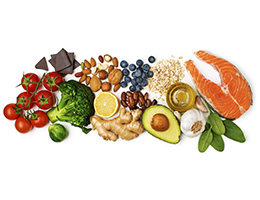
If your blood pressure has crept into a dangerous range, you're going to need to make some changes to bring it under control.
Specifically, your doctor may recommend that you try a special eating plan known as DASH, or Dietary Approaches to Stop Hypertension. In several studies, DASH has been helpful in reducing blood pressure, especially when it's combined with other lifestyle changes, such as cutting back on salt.
DASH basics
Following the DASH diet means cutting back on saturated fat, trans fat and cholesterol and choosing more fruits, vegetables and low-fat dairy foods.
The amount of food you eat in the DASH diet will depend on how many calories you need. A person who is less active needs fewer calories than a person whose work or personal activities are more vigorous.
For a 2,000-calorie-a-day diet, DASH calls for:
- Six to eight servings of grains and grain products a day. Examples of a serving include one slice of bread or half a cup of cooked rice or pasta.
- Four to five servings of vegetables a day. A serving equals one cup of raw, leafy vegetables, half a cup of cooked vegetables or half a cup of vegetable juice.
- Four to five servings of fruits a day. A serving equals one medium fruit, a quarter cup of dried fruit, half a cup of fresh, frozen or canned fruit, or half a cup of fruit juice.
- Two to three servings of low-fat or fat-free dairy foods a day. One serving could be a cup of milk, a cup of yogurt or 1.5 ounces of cheese.
- Six or fewer 1-ounce servings of cooked lean meats, skinless poultry or fish a day.
- Four to five small servings per week of nuts, seeds, dry beans or peas. A serving equals 1.5 ounces of nuts, 2 tablespoons of seeds or half a cup of cooked dry beans or peas.
Only 27% of calories should come from fat, including fat in or added to foods, such as margarine, vegetable oil or mayonnaise.
Sweets—no more than five servings per week—should also be low in fat. Serving-size examples of sweets are a tablespoon of sugar, jelly or jam; half a cup of sorbet; or a cup of lemonade.
The low-salt advantage
Though DASH can help lower your blood pressure, it becomes even more effective if you also cut back on sodium.
In a study funded by the National Heart, Lung, and Blood Institute, people with early-stage high blood pressure who combined a low-salt diet with DASH substantially improved their systolic blood pressure. Participants with the highest blood pressure showed the greatest improvement.
To reduce salt in your diet, begin by checking food labels for sodium content. Choose reduced-sodium or no-salt-added products and use running water to rinse products that contain salt. Limit cured foods and use spices instead of salt when cooking and at the table.
What's next?
Following the DASH diet doesn't guarantee that you won't have to take medicine for high blood pressure, but it could certainly make it more likely. Remember, you'll want to work with your doctor to create a blood pressure control plan that will work best for you.
Reviewed 12/4/2024